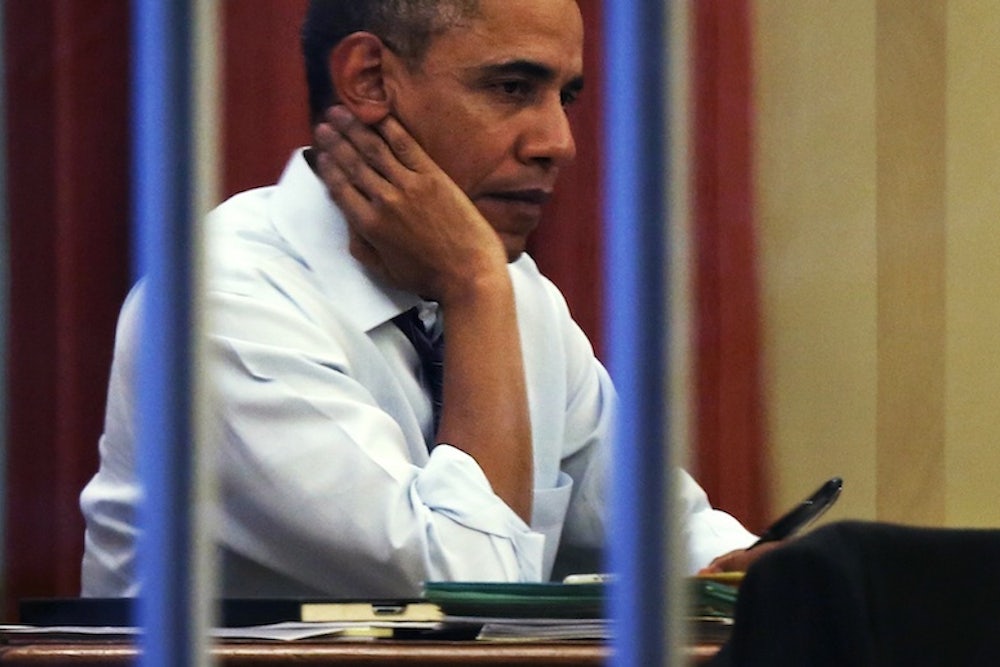In his memo this week, Democratic pollster Stan Greenberg warns me to “forget the conventional wisdom” that “the president is in trouble.” Greenberg points to Barack Obama’s approval rating being up, the Republicans’ reputation at a “remarkable low,” and the generic Congressional vote between the parties being even. Some of this makes sense, but on eve of Obama’s State of the Union address, I’m going with the conventional wisdom: Obama and the Democrats are in deep trouble.
Greenberg cites an improvement in Obama and the Democrats’ polling numbers over the last month, but the improvement is very slight. What I’d point to instead is a comparison between where Obama and the Democrats stood in January 2010 and where they stand today. In January 2010, they were about to lose the Massachusetts senate race, and in November 2010 would lose 63 seats in the House and six seats in the Senate. If Obama and the Democrats’ numbers are better now than they were then, they may not be in trouble; but if they’re worse, the conventional wisdom is right. And they’re worse.
The most recent standard of comparison is the ABC/Washington Post poll that asked some of the same questions in January 2010. First, there are the questions about Obama. These are relevant because midterm elections are often referenda on the president and his party. In January 2010, Obama’s approval ratings were 53 approval to 44 percent disapproval of his “handling his job as president.” Today, 46 percent approve and 50 percent disapprove—a 13-point swing. In January 2010, 47 percent approved and 52 percent disapproved of his handling of the economy. Today 43 percent approve and 55 percent disapprove—a seven-point swing.
In January 2010, 57 percent of registered voters thought that Obama understood “the problems of people like you.” Forty-two percent did not. Today, it’s 47 to 52 percent—a 20-point swing. And there is a similar 20-point swing in the question of how much confidence voters have in Obama’s ability to “make the right decisions for the country’s future.” In short, the electorate has far less confidence in Obama now than they did in January 2010.
ABC–Washington Post didn’t ask the same questions about Democrats and Republicans in January 2010 that they asked today, but they did ask these questions in October 2010 on the eve of the Republicans’ sweep. In October 2010, voters thought Democrats would do a better job than Republicans handling the economy by 44 to 37 percent. Today, they think Republicans would do a better job by 44 to 37 percent—a 14-point turnaround. In October 2010, voters said (incredibly) that they preferred Democratic House candidates by 49 to 44 percent. Today, they prefer Republicans by 45 to 46 percent. The number for October 2010 may be inaccurate, but in any case, there is nothing in the current numbers to inspire confidence. In midterm elections, the Republicans have a built-in advantage that allows them to maintain their majority without winning a majority of votes.
What can be said against the conventional wisdom? First, voters have an unusually low opinion of the Republicans as well as of the Democrats and President Obama. In January 2010, only 24 percent of voters had a great deal or a good amount of confidence in Republicans’ decisions about the country’s future; today, it is down to 19 percent. If Republicans were to behave in the coming year the way they did last fall when they shut down the government, Obama and the Democrats could make up a lot of political ground from what they lost during the Obamacare rollout in October.
Secondly, voters favor the Democrats on several issues that the President and his party are likely to promote this year. These include an increase in minimum wage, immigration (where the Democrats enjoy only a 39 to 37 percent advantage), and extending unemployment insurance. Finally, there is the question of the economy. During 2010, unemployment hovered at about 9.5 percent through the last six months before the election. Voters remained very pessimistic about the country’s economic future. Last month, the unemployment rate dipped below seven percent for the first time since November 2008. If it continues to fall, that will benefit Obama and the Democrats.
But it may not continue falling. As economists Barry Z. Cynamon and Steven M. Fazzari argue in a recent paper, the recovery from the Great Recession has been constrained by a failure of median wages to increase. That has held down the consumer demand that is necessary for a buoyant recovery. They conclude that “a robust recovery is unlikely without policy or other institutional change that at least stops, or even reverse, the trend toward greater income inequality.” But the changes they propose – a “redistributive tax policy” and wage growth tied to productivity growth—are both unlikely to occur this year. Republicans will not back a redistributive tax policy or changes in labor law that would revive the standard remedy—strong labor unions—for keeping wages tied to productivity. There may modest economic improvements over the year, but as happened in 1994, they may not be sufficient to prevent significant Republican gains in November 2014.
